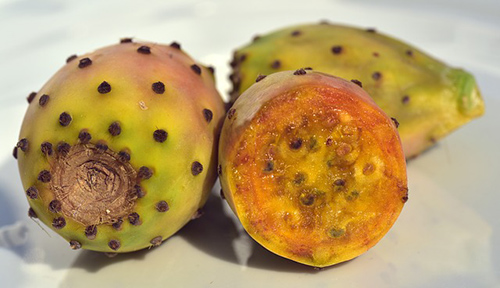Contents
Ancient Mexican natives used prickly pear leaves as poultices to heal wounds and bruises. Spanish colonists brought it to Europe, spreading quickly throughout the Mediterranean basin.
Prickly Pear Scientific Facts

- Other names: Indian fig.
- French: Figuier d’lnde.
- Spanish: Nopal, Chumbera, tuna.
- Environment: Native to Mexico and Central America, now widely spread throughout the Mediterranean basin. It grows in rocky and dry soils.
- Description: Fleshy plant of the Cactaceae family, with fleshy leaves and stems and plenty of juice. It is formed by a series of oval-shaped leaves (pulpy) with prickles or thorns. The fruit is orange or red and is covered by spines.
- Parts of the plant used medicinally: The fruit (Indian figs), the flowers, and the leaves.
Healing Properties and Indications

The fruit of the prickly pear possesses astringent properties and renders good results in stopping summer diarrhea. Their juice is used in Mexico as a syrup to calm coughs.
The flowers have diuretic and antispasmodic properties, used in oliguria (lack of urine production) and cystitis.
The leaves contain high amounts of mucilage and cellulose, which gives them emollient properties. They are used as poultices to heal wounds, bruises, and irritations.
How to use Prickly Pear

- The fruit must be carefully rinsed so as not to touch them with bare fingers because its many prickles are challenging to remove. Fruit can be eaten in syrup or fresh.
- Syrup: It is prepared by slicing the fruit and covering it with brown sugar. Steep for ten hours and then take the syrup (the resulting liquid), straining it to separate seeds. Sip it hot by the spoonful.
- Infusion with 20-30g of flowers per liter of water. Drink 3-4 cups per day.
- Poultices: The leaves are cut, then softly heated in an oven, and directly applied to the affected skin area.
DISCLAIMER: All content on this website is presented solely for educational and informational objectives. It would be best to not rely on the information provided as a replacement for advice, diagnosis, or treatment from a qualified medical expert. If you are pregnant, nursing, or have any preexisting medical concerns, you should talk to your doctor before using any herbal or natural medicines.
REFERENCES
- George D. Pamplona-Roger, M.D. “Encyclopedia of Medicinal Plants.” George D. Pamplona-Roger, M.D. Encyclopedia of Medicinal Plants. Ed. Francesc X. Gelabert. vols. 2 San Fernando de Henares: Editorial Safeliz, 2000. 718. Print.
- Science-Backed Benefits of Prickly Pear Cactus: https://www.healthline.com/nutrition/prickly-pear-benefits
- Betalains in Health and Disease: https://www.ncbi.nlm.nih.gov/pmc/articles/PMC6162729/
